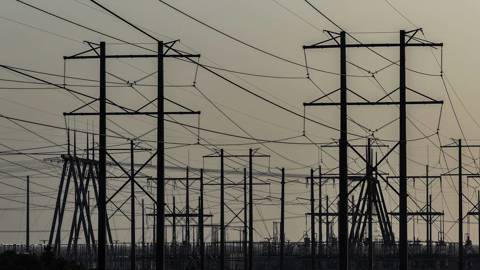Faced with a choice between parasitic capitalism and emerging neo-fascism, it is no wonder that Western societies are increasingly pessimistic. While pessimism has pervaded previous eras, today's mood is sustained, and partly defined, by the absence of a redemptive vision.
LONDON – In 2003, the literary critic Fredric Jameson famously observed that “it is easier to imagine the end of the world than the end of capitalism.” For the first time in two centuries, he noted, capitalism was viewed as both destructive and irreversible. Waning faith in the possibility of a post-capitalist future has nurtured deep pessimism.
This prevailing despair evokes John Maynard Keynes’s 1930 essay “Economic Possibilities for Our Grandchildren,” in which he warned against the “two opposed errors of pessimism.” The first was the pessimism “of the revolutionaries who think that things are so bad that nothing can save us but violent change.” The second was the pessimism of reactionaries who view economic and social structures as “so precarious that we must risk no experiments.”
In response to the pessimisms of his time, Keynes offered an alternative vision, predicting that technology would usher in an era of unprecedented abundance. Within a century, he argued, continuous technological progress would elevate living standards – at least in the “civilized” world – to 4-8 times what they were in the 1920s. This would enable his generation’s grandchildren to work a fraction of the hours their ancestors did.
The short-term employment theory for which Keynes is widely known was part of this larger vision of technological utopia. In his view, running the economy at full capacity was the quickest route from necessity to freedom. Once we achieve this goal, the economic “dentistry” that preoccupied Keynes would become redundant. Our attention could then shift to “our real problems,” those of “life and of human relations, creation, behavior, and religion.”
Although Keynes found Karl Marx’s ideas incomprehensible, his vision of a post-capitalist future resembled that of Marx in The German Ideology. Marx regarded capitalism as a means to address the problem of production, while communism was viewed as a way to manage distribution, thereby eliminating the need for a division of labor.
Much like Keynes, Marx’s vision of the future championed the cultivated amateur, a role traditionally reserved for the aristocracy. Marx envisioned a society where one could “hunt in the morning, fish in the afternoon, rear cattle in the evening,” and “criticize after dinner” without being confined to the role of hunter, fisherman, shepherd, or critic. Like Keynes, he saw capitalism as an ordeal humanity had to endure so that the good life could be democratized.
Although Keynes and Marx viewed capitalism as a necessary evil, both opposed hasty efforts to abolish it or meddle too forcefully in its workings. Keynes warned against prematurely dismantling the capitalist system through wealth and income redistribution, while Marx believed that reformist attempts to humanize capitalism would merely delay the revolution. These rigid stances ultimately proved too extreme for the Keynesians and socialists who sought to establish Keynesian social democracies in the mid-twentieth century.
But despite their utopian visions of a post-capitalist world, Keynes and Marx had fundamentally different views on how to overcome the capitalist “monster,” stemming from their distinct interpretations of the system. For Keynes, capitalism was a spiritual deformation that had spread through Western civilization on the vector of Puritanism and would naturally perish once it was no longer needed. In an era of abundance, “the love of money as a possession – as distinguished from the love of money as a means to the enjoyments and realities of life – will be recognized for what it is,” a “somewhat disgusting morbidity” that one “hands over with a shudder to the specialists in mental disease.”
By contrast, Marx did not view capitalism as a psychological affliction; instead, he saw it as a political and social system wherein the capitalist class monopolized ownership and control of land and capital. This dominance enabled capitalists to extract surplus value from workers, whose only saleable commodity was their labor power. Capitalism, Marx argued, would not simply wither away; it had to be overthrown, but not before its creative potential had been fully realized.
Marx’s portrayal of capitalism as a creative force was rooted in Hegel’s dialectic and significantly influenced by Mary Shelley’s 1818 novel Frankenstein; or, The Modern Prometheus. Another source of inspiration was Goethe’s Faust, where Mephistopheles is depicted as a diligent executor of God’s plan for human redemption.
In many respects, today’s pessimism is more profound than the one Keynes identified in 1930. Leftist revolutionaries still long for capitalism’s downfall, yet they have failed to provide a viable political alternative since the collapse of Soviet communism. Meanwhile, conservatism has evolved into the “radical right,” characterized by resentment and chauvinism but lacking a coherent vision for a harmonious future. Neither side seems to offer a light at the end of the tunnel.
It is the absence of a redemptive vision that sustains, and partly defines, today’s prevailing pessimism. While Keynes and Marx believed in the emancipatory power of machines, technology is now widely viewed as a menace, even as our future remains deeply intertwined with it. Similarly, Keynes and Marx assumed that capitalism would collapse long before nature rebelled against its exploitation; we now face the existential threat of climate change, with little hope of a successful global effort to combat it. Most alarmingly, public trust in the ability of democratic systems to deliver meaningful progress is rapidly eroding.
Faced with a choice between parasitic capitalism and emerging neo-fascism, pessimism is reasonable. But given that neither the end of the world nor the end of capitalism seems imminent, the question remains: Where do we go from here?











LONDON – In 2003, the literary critic Fredric Jameson famously observed that “it is easier to imagine the end of the world than the end of capitalism.” For the first time in two centuries, he noted, capitalism was viewed as both destructive and irreversible. Waning faith in the possibility of a post-capitalist future has nurtured deep pessimism.
This prevailing despair evokes John Maynard Keynes’s 1930 essay “Economic Possibilities for Our Grandchildren,” in which he warned against the “two opposed errors of pessimism.” The first was the pessimism “of the revolutionaries who think that things are so bad that nothing can save us but violent change.” The second was the pessimism of reactionaries who view economic and social structures as “so precarious that we must risk no experiments.”
In response to the pessimisms of his time, Keynes offered an alternative vision, predicting that technology would usher in an era of unprecedented abundance. Within a century, he argued, continuous technological progress would elevate living standards – at least in the “civilized” world – to 4-8 times what they were in the 1920s. This would enable his generation’s grandchildren to work a fraction of the hours their ancestors did.
The short-term employment theory for which Keynes is widely known was part of this larger vision of technological utopia. In his view, running the economy at full capacity was the quickest route from necessity to freedom. Once we achieve this goal, the economic “dentistry” that preoccupied Keynes would become redundant. Our attention could then shift to “our real problems,” those of “life and of human relations, creation, behavior, and religion.”
Although Keynes found Karl Marx’s ideas incomprehensible, his vision of a post-capitalist future resembled that of Marx in The German Ideology. Marx regarded capitalism as a means to address the problem of production, while communism was viewed as a way to manage distribution, thereby eliminating the need for a division of labor.
Much like Keynes, Marx’s vision of the future championed the cultivated amateur, a role traditionally reserved for the aristocracy. Marx envisioned a society where one could “hunt in the morning, fish in the afternoon, rear cattle in the evening,” and “criticize after dinner” without being confined to the role of hunter, fisherman, shepherd, or critic. Like Keynes, he saw capitalism as an ordeal humanity had to endure so that the good life could be democratized.
SPRING SALE: Save 40% on all new Digital or Digital Plus subscriptions
Subscribe now to gain greater access to Project Syndicate – including every commentary and our entire On Point suite of subscriber-exclusive content – starting at just $49.99.
Subscribe Now
Although Keynes and Marx viewed capitalism as a necessary evil, both opposed hasty efforts to abolish it or meddle too forcefully in its workings. Keynes warned against prematurely dismantling the capitalist system through wealth and income redistribution, while Marx believed that reformist attempts to humanize capitalism would merely delay the revolution. These rigid stances ultimately proved too extreme for the Keynesians and socialists who sought to establish Keynesian social democracies in the mid-twentieth century.
But despite their utopian visions of a post-capitalist world, Keynes and Marx had fundamentally different views on how to overcome the capitalist “monster,” stemming from their distinct interpretations of the system. For Keynes, capitalism was a spiritual deformation that had spread through Western civilization on the vector of Puritanism and would naturally perish once it was no longer needed. In an era of abundance, “the love of money as a possession – as distinguished from the love of money as a means to the enjoyments and realities of life – will be recognized for what it is,” a “somewhat disgusting morbidity” that one “hands over with a shudder to the specialists in mental disease.”
By contrast, Marx did not view capitalism as a psychological affliction; instead, he saw it as a political and social system wherein the capitalist class monopolized ownership and control of land and capital. This dominance enabled capitalists to extract surplus value from workers, whose only saleable commodity was their labor power. Capitalism, Marx argued, would not simply wither away; it had to be overthrown, but not before its creative potential had been fully realized.
Marx’s portrayal of capitalism as a creative force was rooted in Hegel’s dialectic and significantly influenced by Mary Shelley’s 1818 novel Frankenstein; or, The Modern Prometheus. Another source of inspiration was Goethe’s Faust, where Mephistopheles is depicted as a diligent executor of God’s plan for human redemption.
In many respects, today’s pessimism is more profound than the one Keynes identified in 1930. Leftist revolutionaries still long for capitalism’s downfall, yet they have failed to provide a viable political alternative since the collapse of Soviet communism. Meanwhile, conservatism has evolved into the “radical right,” characterized by resentment and chauvinism but lacking a coherent vision for a harmonious future. Neither side seems to offer a light at the end of the tunnel.
It is the absence of a redemptive vision that sustains, and partly defines, today’s prevailing pessimism. While Keynes and Marx believed in the emancipatory power of machines, technology is now widely viewed as a menace, even as our future remains deeply intertwined with it. Similarly, Keynes and Marx assumed that capitalism would collapse long before nature rebelled against its exploitation; we now face the existential threat of climate change, with little hope of a successful global effort to combat it. Most alarmingly, public trust in the ability of democratic systems to deliver meaningful progress is rapidly eroding.
Faced with a choice between parasitic capitalism and emerging neo-fascism, pessimism is reasonable. But given that neither the end of the world nor the end of capitalism seems imminent, the question remains: Where do we go from here?